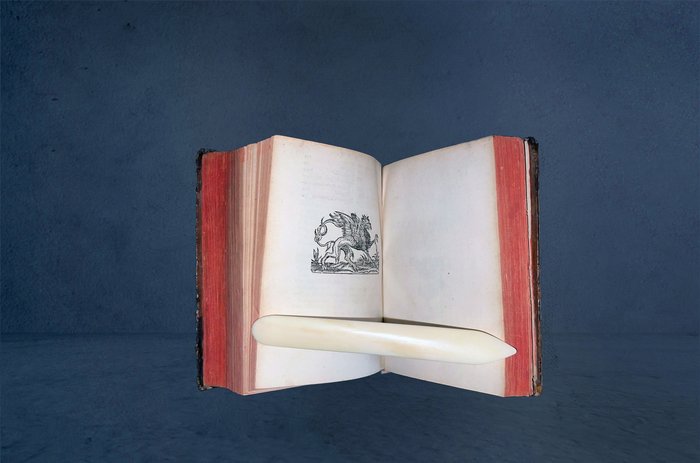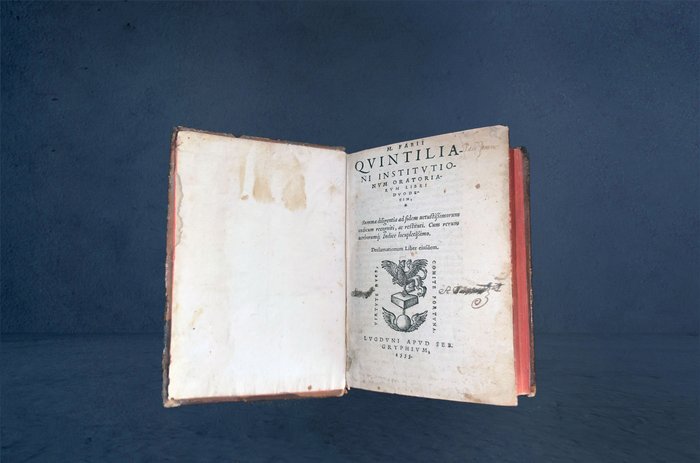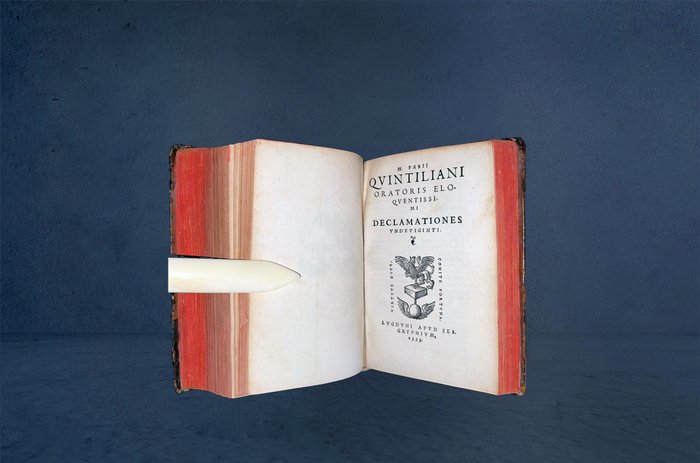Advert Description
Are you interested in this item? This item is up for auction at Catawiki. Please click on "respond to advert" (orange button) to get redirected to the Catawiki website. Catawiki’s goal is to make special objects universally available. Our weekly auctions feature thousands of unusual, rare, and exceptional objects you won’t find in just any store. - M. Fabii Quintiliani Institutionum oratoriarum libri duodecim. Summa diligentia ad fidem vetustissimorum codicum recogniti, ac restituti. Cum rerum verborumque index locupletissimo.
- M. Fabii Quintiliani oratoris eloquentissimi Declamationes undeviginti.
Lugduni : apud Seb. Gryphium, 1555. (16 x 12 cm) . Collation: 741, [90] ; 269 p. ; 8th."
2 volumes in 1 volume. Complete work. good condition Well curdled book. It only has a few minor problems, a few leaves affected by a small trace of a xylophagous insect and also leaves with traces of old moisture in the first 150 sheets or so, with different intensities and sizes, annotations from the old owner on a few sheets, for the rest everything correct, good laid paper, clean pages. Coat of arms of the printer on the last page of the first volume. Nice drop caps.
The binding is surely after 1555, I would bet that it is from the beginning of the 18th century due to the style, likewise, great binding in full calfskin, somewhat scuffed although well preserved, with a spine ornamented with a tile and golden rosettes. embellished cuts. Beautiful copy.
CCPB000022176-7
Marco Fabio Quintiliano, in Latin Marcus Fabius Quintilianus (Calagurris Nassica Iulia, c. 35-Rome, c. 95) was a Hispano-Roman rhetorician and pedagogue.
His fame comes from his Institutio oratoria (c. AD 95), an encyclopedic work that includes everything necessary to train an orator, in twelve volumes. As the supreme model he proposes Cicero. In the first two books, Quintilian deals with elementary education and the methods for basic training in the field of Rhetoric. The future orator must have a good litterator and a good grammaticus, teachers largely forgotten in those days by the hegemony of the rhetor. He dedicates the following nine books to the fundamentals and techniques of oratory: from the third to the seventh, for example, he already exposes the inventio and elocutio phases of the method of composition of any speech, and concludes the third with a description of the three oratorical genres. which is inspired by Aristotle's Rhetoric and Poetics: the judicial genre, the deliberative or sumbuletic and the demonstrative or epidictic; in the fourth it deals with the parts of the speech, namely, exordio (preamble or introduction), the narratio or description of the facts, the argumentation, the rapid digression, the proposition and the division; from the eighth to the tenth he treats the elocutio; the eleventh deals with memory and actio, and the twelfth deals with the qualities, character, ethics and deontology that the speaker must possess.
Inventio ("invention"): find what to say and select the most suitable.
Dispositio ("ordering"): knowing how to organize what is going to be said in the order most conducive to the end pursued.
Elocutio ("expression"): choose the best way, words and style to seduce with what is said.
Actio ("declamation"): know how to combine the word, tone and gesture, and adapt the speech to the circumstances in which it is pronounced.
Memory ("memory"): mnemonics, or ways of retaining what needs to be said and not forgetting it.
Book X is the best known; in it he recommends reading as a fundamental element in the formation of a speaker and contains a famous study on Greek and Latin authors.
The work defends the integral formation of the orator as a human being and as a public figure and presents remarkable originality with a lucid and brilliant Ciceronian style; exerted a great influence on the pedagogical theory that sustains Humanism and the Renaissance and was translated directly from Latin into Spanish according to the (abbreviated) edition of Charles Rollin (probably the posthumous ones from Padua, 1760 or the one from Paris, 1774) by the parents Piarists Ignacio Rodríguez de San José de Calasanz (1765-1808) and Pedro Sandier de San Basilio (1763-1812): Oratory Institutions of the famous Spanish M. Fabio Quintiliano... Madrid: Ranz Library, 1799, 2 vols.); it was reprinted in 1887 (Madrid: Librería de la Viuda de Hernando y Cía), in 1911 and in 1916 (Madrid: Librería de Perlado y Páez) and 1944 (Buenos Aires: Joaquín Gil). The most reliable and modern edition is therefore the bilingual one by Alfonso Ortega Carmona (Salamanca: Publicaciones de la Universidad Pontificia / Caja de Salamanca y Soria, 1996) in six volumes. 67454105





